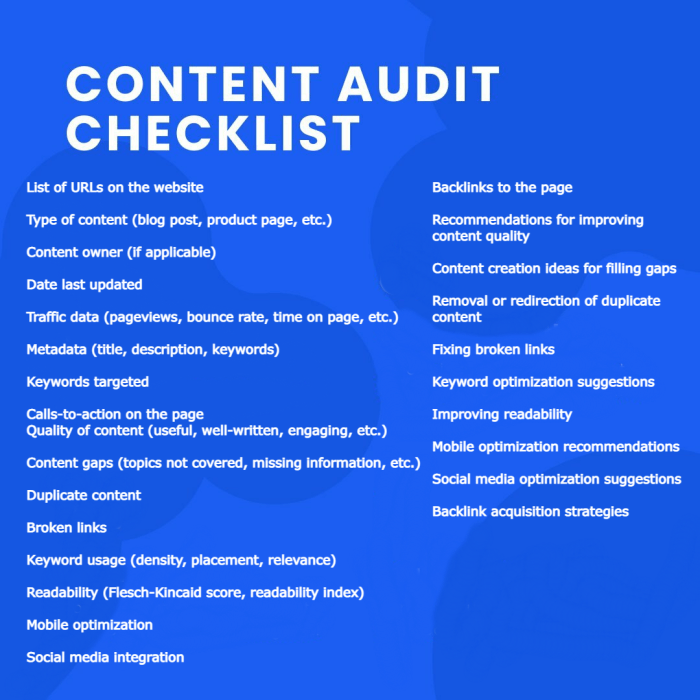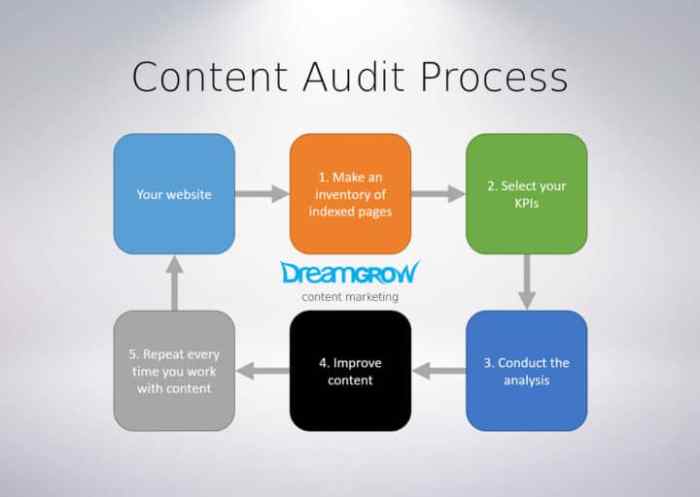Creating a Content Audit takes center stage, inviting you into a world of website optimization with a touch of high school hip style. Get ready to dive into the essentials of auditing your content for maximum impact!
Understanding Content Audit

A content audit is like taking a deep dive into your website to see what’s kickin’ and what’s whack. It’s basically a thorough analysis of all the content on your site, from blog posts to product pages, to make sure everything is on point.
Importance of Conducting a Content Audit
Before you start dropping new content like it’s hot, it’s crucial to conduct a content audit to see where you’re at. This helps you understand what’s working, what needs to be updated, and what’s straight-up irrelevant.
- Identify outdated content that needs a fresh makeover.
- Prioritize content that’s driving the most traffic and engagement.
- Ensure consistency in branding and messaging across all pages.
Benefits of Performing a Content Audit Regularly
Regular content audits are key to keeping your website game strong and your audience coming back for more. Check it:
- Improved by optimizing s and updating meta tags.
- Enhanced user experience by removing outdated or redundant content.
- Increased conversion rates by aligning content with audience needs and preferences.
Types of Content Audits

When it comes to content audits, there are two main types that are commonly used in the industry: quantitative and qualitative content audits. Each type serves a different purpose and provides unique insights into the performance and effectiveness of your content strategy.
Quantitative Content Audits
Quantitative content audits focus on the numerical data and metrics associated with your content. This includes analyzing data such as page views, bounce rates, click-through rates, and social shares. By looking at these quantitative metrics, you can gain a better understanding of how your content is performing in terms of reach, engagement, and overall impact.
- Tools used for conducting quantitative content audits include Google Analytics, SEMrush, and Moz.
- Quantitative content audits are essential for tracking the success of your content strategy and identifying areas for improvement.
- By analyzing quantitative data, you can make data-driven decisions to optimize your content and drive better results.
Qualitative Content Audits
Qualitative content audits, on the other hand, focus on the quality and relevance of your content. This involves assessing factors such as tone, voice, messaging, and overall user experience. Qualitative audits provide insights into the effectiveness of your content in terms of engaging and resonating with your target audience.
- Tools commonly used for conducting qualitative content audits include Hotjar, Crazy Egg, and UserTesting.
- Qualitative content audits help you understand how your content is perceived by your audience and identify areas for improvement in terms of messaging and user experience.
- By analyzing qualitative data, you can uncover valuable insights that can inform your content strategy and help you create more impactful and engaging content.
Manual vs Automated Content Audits
Manual content audits involve a human reviewer manually analyzing and assessing content based on predefined criteria. This can be a time-consuming process but allows for a more in-depth and nuanced analysis of content quality and effectiveness.Automated content audits, on the other hand, utilize software tools and algorithms to analyze content at scale. This approach is faster and more efficient, but may lack the human touch and context provided by manual audits.
- Manual content audits are ideal for detailed qualitative analysis and personalized insights.
- Automated content audits are useful for quickly assessing large volumes of content and identifying trends and patterns.
- Combining both manual and automated content audits can provide a comprehensive view of your content strategy and help you make informed decisions to optimize your content performance.
Steps to Perform a Content Audit
Before diving into a content audit, it’s crucial to prepare adequately to ensure a smooth and effective process. This involves outlining your goals, defining key metrics for evaluation, and setting up a systematic approach to analyzing your content.
Initial Preparation Steps
- Define the purpose of the content audit, whether it’s to improve , enhance user experience, or align content with business goals.
- Identify key performance indicators (KPIs) to measure the success of the audit, such as traffic, engagement, conversions, and bounce rates.
- Establish a timeline and allocate resources for the audit, including personnel, tools, and budget.
- Create a checklist or template to standardize the audit process and ensure consistency in evaluation.
Inventorying Existing Content
- Compile a comprehensive list of all content assets, including web pages, blog posts, videos, infographics, and social media posts.
- Categorize content based on type, format, topic, and target audience to facilitate analysis.
- Document metadata for each piece of content, such as publication date, author, s, and URL, for reference during the audit.
- Use content inventory tools like Screaming Frog, SEMrush, or Google Analytics to automate the collection process and ensure no content is overlooked.
Analyzing and Evaluating Content
- Assess the quality of content based on relevance, accuracy, credibility, and engagement metrics like time on page and social shares.
- Identify content gaps and duplication to streamline the content strategy and improve overall coherence and consistency.
- Analyze content performance against KPIs to determine successful pieces and areas for improvement or optimization.
- Engage stakeholders and content creators in the evaluation process to gather insights and feedback for future content planning.
Organizing Audit Findings
When it comes to organizing the findings of a content audit, it is crucial to categorize the content based on the audit results. This helps in identifying patterns, strengths, and weaknesses in the content strategy. One effective way to do this is by creating a content inventory spreadsheet.
Categorizing Content, Creating a Content Audit
Creating categories such as blog posts, product pages, landing pages, videos, etc., can help in grouping similar content together. This makes it easier to analyze and prioritize updates or removals based on the audit findings.
Importance of Content Inventory Spreadsheet
A content inventory spreadsheet serves as a centralized document where all the content audit findings can be recorded. It provides a clear overview of the current state of the content and helps in tracking changes over time. Additionally, it enables easy collaboration among team members involved in the content strategy.
Prioritizing Content Updates
Once the content is categorized and listed in the inventory spreadsheet, it is essential to prioritize updates based on factors like traffic, engagement metrics, relevance, and alignment with business goals. Content that is outdated, irrelevant, or underperforming should be considered for removal or updates to improve its effectiveness.
Implementing Changes: Creating A Content Audit
To implement changes based on the content audit recommendations, it is essential to create a detailed action plan that addresses each finding effectively. This action plan should prioritize the most critical issues identified during the audit and Artikel clear steps for updating, repurposing, or removing content as needed.
Creating an Action Plan
- Review the audit findings and prioritize the recommendations based on their impact on overall content quality and performance.
- Assign responsibilities to team members for each task to ensure accountability and timely completion.
- Set specific goals and objectives for each change to measure success and track progress effectively.
- Establish a timeline for implementing the changes, considering factors like resources, constraints, and dependencies.
Updating, Repurposing, or Removing Content
After the audit, it is crucial to update outdated content, repurpose underperforming content, and remove irrelevant or low-quality content. Strategies for this include:
- Refreshing existing content with updated information, statistics, and visuals to improve relevance and engagement.
- Repurposing content into different formats like videos, infographics, or podcasts to reach a wider audience and enhance user experience.
- Removing duplicate, thin, or low-performing content to declutter the website and improve overall performance.
Monitoring the Impact of Changes
To track the effectiveness of content changes post-audit, it is essential to:
- Monitor key performance indicators (KPIs) such as traffic, engagement, conversion rates, and bounce rates to assess the impact of the changes.
- Use analytics tools to measure the before-and-after performance of updated content and compare results to evaluate success.
- Solicit feedback from users through surveys, comments, and social media to gather insights on how the changes have been perceived and received.
Tools and Software for Content Audits
When it comes to conducting a content audit, having the right tools and software can make the process much smoother and more efficient. There are several popular options available in the market that cater to different needs and preferences. Let’s take a look at some of the top tools and software used for content audits and compare their features to help beginners choose the right one for their audit needs.
Popular Tools for Content Audits
- 1. Screaming Frog: Screaming Frog is a powerful website crawler that can help you analyze your content inventory, identify duplicate content, broken links, and other issues that need attention.
- 2. SEMrush: SEMrush offers a suite of tools that can assist in content audits by providing insights into rankings, backlinks, and overall site health.
- 3. Ahrefs: Ahrefs is another comprehensive tool that can help you track your content performance, analyze competitor content, and optimize your site for search engines.
Comparing Features of Content Audit Tools
| Tool | Key Features |
|---|---|
| Screaming Frog | Website crawling, content analysis, broken link detection. |
| SEMrush | research, backlink analysis, site audit. |
| Ahrefs | Competitor analysis, content optimization, rank tracking. |
Recommendations for Beginners
- Consider your specific needs: Choose a tool that aligns with your goals and objectives for the content audit.
- Ease of use: Opt for a tool that is user-friendly and provides clear instructions for beginners.
- Budget considerations: Evaluate the cost of the tool and determine if it fits within your budget constraints.